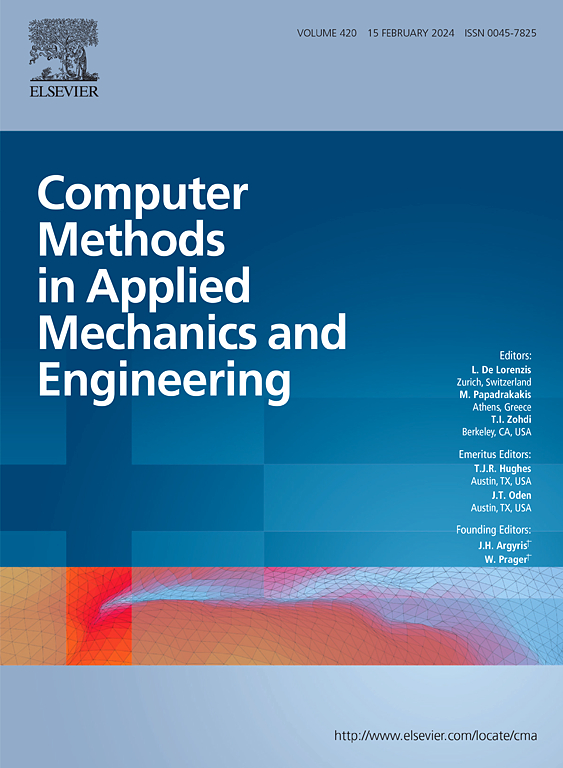Control of the accuracy and improvement of the convergence rate of a LATIN-based multiscale strategy for frictional contact problems
IF 7.3
1区 工程技术
Q1 ENGINEERING, MULTIDISCIPLINARY
Computer Methods in Applied Mechanics and Engineering
Pub Date : 2025-07-30
DOI:10.1016/j.cma.2025.118268
引用次数: 0
Abstract
This paper deals with the control and improvement of the convergence of the interface contact quantities in the framework of a multiscale strategy for the resolution of time-dependent frictional contact problems. The considered strategy is the multiscale mixed domain decomposition method based on the LATIN non-incremental solver, whose specificity is that it generates successive approximations of the solution over the entire space-time domain. In order to highlight this characteristic of the method, in a previous paper [1], the robustness of the strategy was pointed out, but also how challenging it is to control the accurate convergence of microquantities at the interfaces and how the convergence rate of microquantities depends on the parameters of search directions used in the LATIN, in a manner similar to the influence of augmentation parameters in augmented Lagrangian approaches combined with an Uzawa-like solver. The objective of this work is to propose, first of all, a dedicated convergence indicator in order to stop the iterative process of the resolution strategy for ensuring converged contact quantities with a reasonable level of accuracy. Such a convergence indicator is crucial for the second part of the paper, where a strategy is introduced for the on-the-fly updating of search directions along the LATIN iterations based on the contact status in space and time to improve the convergence rate of the interface quantities. The robustness of the convergence indicator and the updating strategy is tested on several 2D frictional contact problems with multiple contact interfaces and different time-evolving contact conditions (open/closed and stick/slip transitions), allowing for accurate control and improved convergence rate of local microquantities, especially when a high level of accuracy is required.
基于拉丁文的摩擦接触问题多尺度策略的精度控制和收敛速度的提高
本文研究了在多尺度策略框架下解决时变摩擦接触问题的界面接触量收敛性的控制和改进。所考虑的策略是基于拉丁非增量求解器的多尺度混合域分解方法,其特点是在整个时空域上生成解的连续逼近。为了突出该方法的这一特点,在之前的一篇论文[1]中,指出了该策略的鲁棒性,但也指出了控制界面处微量的精确收敛是多么具有挑战性,以及微量的收敛速度如何依赖于拉丁文中使用的搜索方向参数,这与增广拉格朗日方法中结合uzawa求解器的增广参数的影响类似。本工作的目的是首先提出一个专用的收敛指标,以停止分辨率策略的迭代过程,以确保具有合理精度水平的收敛接触量。这种收敛性指标在本文的第二部分是至关重要的,在第二部分中引入了一种基于空间和时间上的接触状态沿拉丁迭代动态更新搜索方向的策略,以提高界面量的收敛速度。收敛指标和更新策略的鲁棒性在几个具有多个接触界面和不同时间演变接触条件(开/闭和粘/滑过渡)的二维摩擦接触问题上进行了测试,允许精确控制和提高局部微量的收敛速度,特别是在需要高精确度的情况下。
本文章由计算机程序翻译,如有差异,请以英文原文为准。
求助全文
约1分钟内获得全文
求助全文
来源期刊
CiteScore
12.70
自引率
15.30%
发文量
719
审稿时长
44 days
期刊介绍:
Computer Methods in Applied Mechanics and Engineering stands as a cornerstone in the realm of computational science and engineering. With a history spanning over five decades, the journal has been a key platform for disseminating papers on advanced mathematical modeling and numerical solutions. Interdisciplinary in nature, these contributions encompass mechanics, mathematics, computer science, and various scientific disciplines. The journal welcomes a broad range of computational methods addressing the simulation, analysis, and design of complex physical problems, making it a vital resource for researchers in the field.

 求助内容:
求助内容: 应助结果提醒方式:
应助结果提醒方式:


